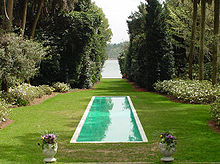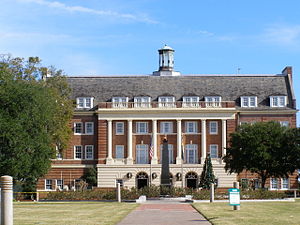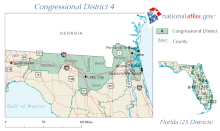Geography
[1] Tallahassee has an area of 98.2 square miles (254.3 km
2), of which 95.7 square miles (247.9 km
2) is land and 2.5 square miles (6.5 km
2) (2.59%) is water.
Tallahassee's terrain is hilly by Florida standards, being located at the southern end of the
Red Hills Region, just above the
Cody Scarp.
The elevation varies from near sea level to just over 200 feet (61 m),
with the state capitol on one of the highest hills in the city. The city
includes two large lake basins,
Lake Jackson and
Lake Lafayette, and borders the northern end of the
Apalachicola National Forest.
The flora and fauna are similar to those found in the mid-south and low country regions of
South Carolina and
Georgia. The palm trees are the more cold-hardy varieties like the state tree, the
Sabal palmetto. Pines, magnolias, hickories, and a variety of oaks are the dominant trees. The
Southern Live Oak is perhaps the most emblematic of the city.
Climate
Unlike most of Florida, Tallahassee experiences all four seasons. Shown
are the autumn leaves along the sidewalks of Monroe Street in Downtown
Tallahassee.
Tallahassee has a
humid subtropical climate (
Köppen Cfa),
with long summers and short, mild winters, as well as drier springs and
autumns. Summers here are hotter than in the Florida peninsula and it
is one of the few cities in the state to occasionally record
temperatures above 100 °F or 37.8 °C, averaging 2.4 days annually.
[19] The record high of 105 °F (41 °C) was set on June 15, 2011.
[20]
Summer is characterized by brief intense
showers and
thunderstorms that form along the afternoon
sea breeze from the
Gulf of Mexico.
The daily mean temperature in July, the hottest month, is 82.0 °F
(27.8 °C). Conversely, the city is markedly cooler in the winter, with a
January daily average temperature of 51.2 °F (10.7 °C). In addition, as
Tallahassee straddles the boundary between
USDA Hardiness Zones 8B and 9A,
[21] the coldest temperature of the season is typically around 20 °F or −6.7 °C. During the
Great Blizzard of 1899
the city reached −2 °F (−18.9 °C), the only recorded sub-zero
Fahrenheit reading in Florida and actually colder than the record low in
Ketchikan, Alaska and
Tromso, Norway.
Snow and ice are rare in Tallahassee. Nonetheless, over the last 100
years, the city has recorded some accumulating snowfalls; the heaviest
was 2.8 inches (0.07 m) on February 13, 1958. A
White Christmas occurred in 1989,
[22]
and during the March 13–14, 1993 eastern U.S. “superstorm”, there were
high winds and traces of snow. Historically, the city usually records at
least flurries every three to four years, but on average, measurable
amounts of snow 1.0 inch (2.5 cm) occur only once every 17 years. The
last measurable snowfall took place December 22–23, 1989. The natural
snow line (regular yearly snowfalls) ends 200 miles (320 km) to the
north at
Macon, Georgia,
but the city averages 32 nights where the temperature falls below
freezing, and, on average, the first freeze occurs on November 20, the
last on March 22.
[19]
Although several hurricanes have brushed Tallahassee with their outer rain and wind bands, in recent years only
Hurricane Kate, in 1985, has struck Tallahassee directly. The Big Bend area of North Florida sees several
tornadoes
each year during the season, but they are generally weak, cause little
structural damage, and rarely hit the city directly. The most recent
tornado to hit Tallahassee occurred on April 19, 2015. The tornado was
classified as an
EF1, and created a path as wide as 350 yards for almost 5 miles near Maclay Gardens.
[23]
Damage included numerous downed tree limbs and a car crushed by a
falling tree. During extremely heavy rains, some low-lying parts of
Tallahassee may flood, notably the Franklin Boulevard area adjacent to
the downtown and the Killearn Lakes subdivision (which is not within the
city limits proper) on the north side.
| [hide]Climate data for Tallahassee, Florida (Tallahassee Regional Airport), 1981–2010 normals, extremes 1892–present |
| Month |
Jan |
Feb |
Mar |
Apr |
May |
Jun |
Jul |
Aug |
Sep |
Oct |
Nov |
Dec |
Year |
| Record high °F (°C) |
83
(28) |
89
(32) |
91
(33) |
95
(35) |
102
(39) |
105
(41) |
104
(40) |
103
(39) |
102
(39) |
95
(35) |
89
(32) |
84
(29) |
105
(41) |
| Average high °F (°C) |
63.5
(17.5) |
67.5
(19.7) |
73.8
(23.2) |
79.9
(26.6) |
87.0
(30.6) |
91.0
(32.8) |
92.1
(33.4) |
91.5
(33.1) |
88.4
(31.3) |
81.4
(27.4) |
73.0
(22.8) |
65.3
(18.5) |
79.6
(26.4) |
| Daily mean °F (°C) |
51.2
(10.7) |
54.7
(12.6) |
60.4
(15.8) |
66.1
(18.9) |
74.3
(23.5) |
80.2
(26.8) |
82.0
(27.8) |
81.8
(27.7) |
78.2
(25.7) |
69.4
(20.8) |
60.2
(15.7) |
53.2
(11.8) |
67.6
(19.8) |
| Average low °F (°C) |
39.0
(3.9) |
41.9
(5.5) |
47.1
(8.4) |
52.3
(11.3) |
61.6
(16.4) |
69.5
(20.8) |
72.0
(22.2) |
72.1
(22.3) |
68.1
(20.1) |
57.3
(14.1) |
47.5
(8.6) |
41.1
(5.1) |
55.8
(13.2) |
| Record low °F (°C) |
6
(−14) |
−2
(−19) |
20
(−7) |
29
(−2) |
34
(1) |
46
(8) |
57
(14) |
57
(14) |
40
(4) |
29
(−2) |
13
(−11) |
10
(−12) |
−2
(−19) |
| Average rainfall inches (mm) |
4.34
(110.2) |
4.84
(122.9) |
5.92
(150.4) |
3.06
(77.7) |
3.47
(88.1) |
7.73
(196.3) |
7.28
(184.9) |
7.34
(186.4) |
4.68
(118.9) |
3.23
(82) |
3.49
(88.6) |
3.90
(99.1) |
59.28
(1,505.5) |
| Average rainy days (≥ 0.01 inch) |
8.9 |
8.4 |
7.9 |
6.1 |
7.1 |
13.6 |
15.9 |
14.4 |
8.5 |
5.7 |
6.6 |
8.1 |
111.2 |
| Source: NOAA[19][24] |
 Interstate 10
runs east and west across the north side of the city. Tallahassee is
served by five exits including: Exit 192 (U.S. 90), Exit 196 (Capital
Circle NW), Exit 199 (U.S. 27/Monroe St.), Exit 203 (U.S.
319/Thomasville Road and Capital Circle NE), and Exit 209 (U.S. 90/Mahan
Dr.)
Interstate 10
runs east and west across the north side of the city. Tallahassee is
served by five exits including: Exit 192 (U.S. 90), Exit 196 (Capital
Circle NW), Exit 199 (U.S. 27/Monroe St.), Exit 203 (U.S.
319/Thomasville Road and Capital Circle NE), and Exit 209 (U.S. 90/Mahan
Dr.) U.S. Route 27
enters the city from the northwest before turning south and entering
downtown. This portion of U.S. 27 is known locally as Monroe Street. In
front of the historic state capitol building, U.S. 27 turns east and
follows Apalachee Parkway out of the city.
U.S. Route 27
enters the city from the northwest before turning south and entering
downtown. This portion of U.S. 27 is known locally as Monroe Street. In
front of the historic state capitol building, U.S. 27 turns east and
follows Apalachee Parkway out of the city. U.S. Route 90
runs east and west through Tallahassee. It is known locally as
Tennessee Street west of Magnolia Drive and Mahan Drive east of
Magnolia.
U.S. Route 90
runs east and west through Tallahassee. It is known locally as
Tennessee Street west of Magnolia Drive and Mahan Drive east of
Magnolia. U.S. Route 319
runs north and south along the east side of the city using Thomasville
Road, Capital Circle NE, Capital Circle SE, and Crawfordville Road.
U.S. Route 319
runs north and south along the east side of the city using Thomasville
Road, Capital Circle NE, Capital Circle SE, and Crawfordville Road. State Road 20
State Road 20 State Road 61
State Road 61 State Road 363
State Road 363

















